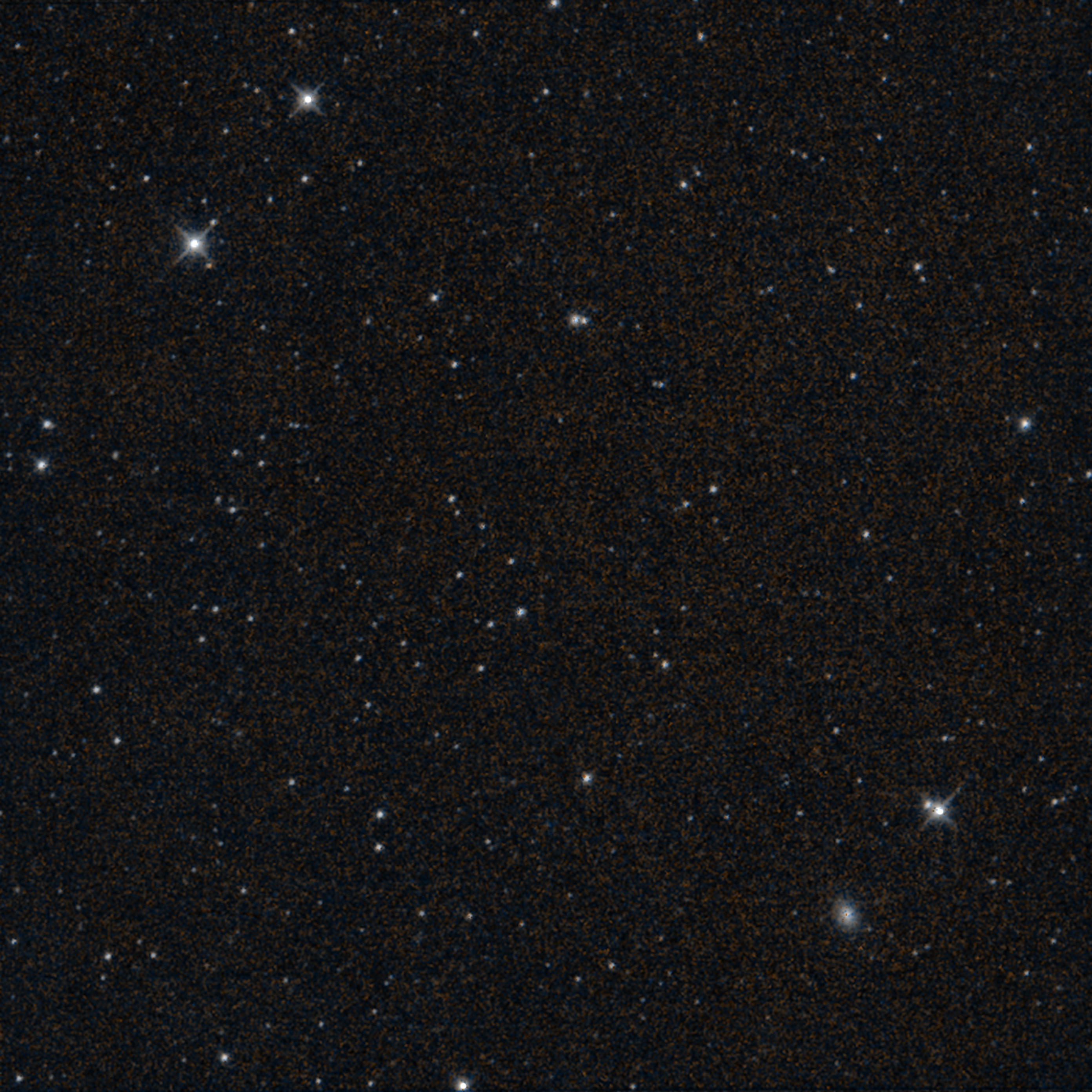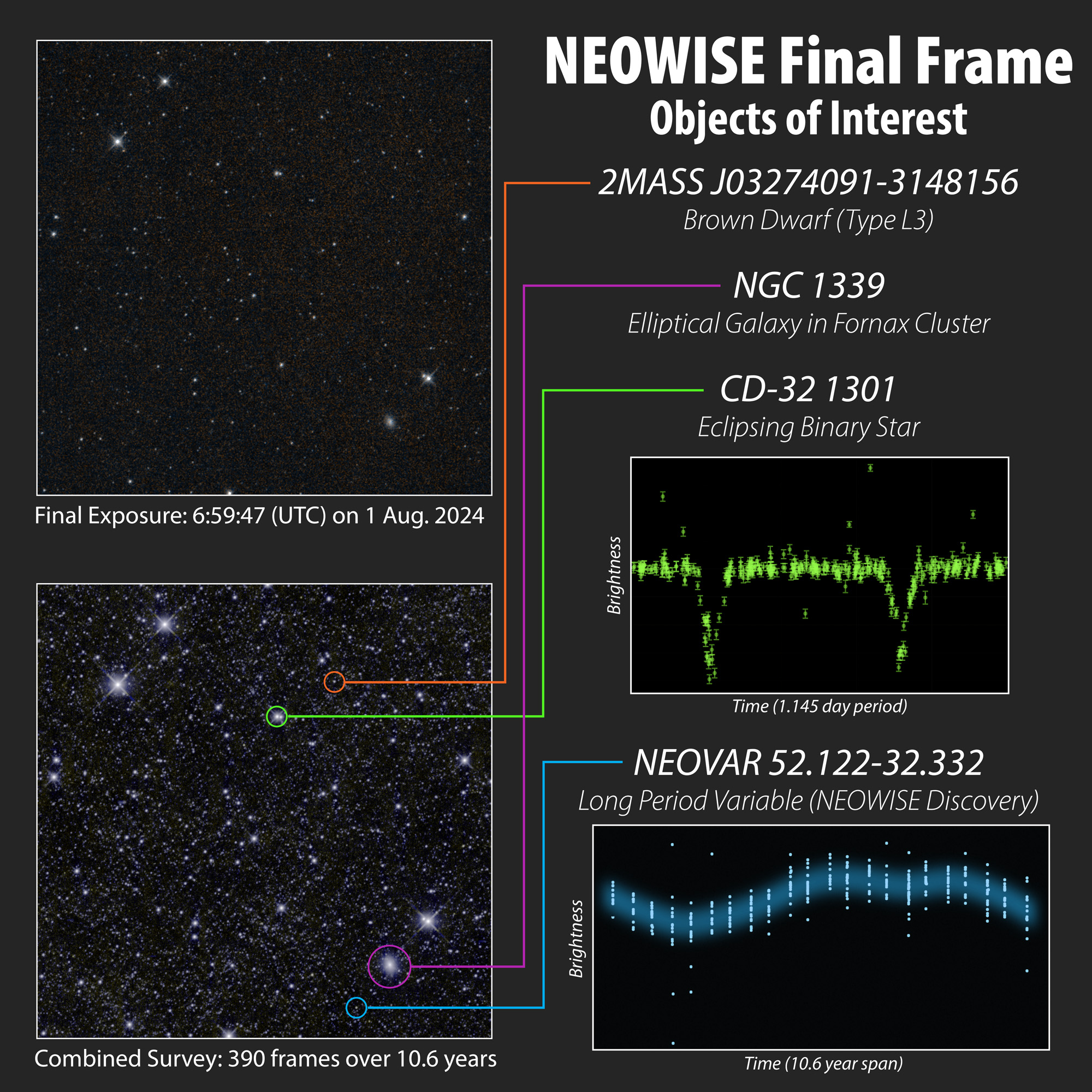
Written by Isabel Swafford
August 7, 2024
Around midnight on July 31 in Pasadena, California, NASA's NEOWISE spacecraft made its final record of the infrared sky. This was the final observation that the prolific telescope would make of our cosmic neighborhood, after nearly 30 million total observations during its lifetime, first as the Wide-field Infrared Survey Explorer (WISE) and then later as the NEOWISE reactivation, the asteroid-hunting phase of the mission.
With the spacecraft set to be decommissioned on August 8, it is a bittersweet moment for Roc Cutri, NEOWISE Lead Scientist and Task Lead at IPAC.
"It's always hard to say goodbye, but I am endlessly proud of the NEOWISE team here at IPAC and of all of the innovations made and knowledge gained," said Cutri. "I know NEOWISE's scientific impact will long outlast the spacecraft itself."
The primary goal of NEOWISE, the reactivation of the former WISE mission, was to search for and characterize asteroids and other near-Earth objects (NEOs) that could be potentially hazardous to Earth. NEOWISE did this by repeatedly surveying the entire sky, looking for changing or moving objects. The telescope observed our solar system and beyond in infrared light – wavelengths well-suited for observing faint, cool objects such as asteroids.
But just as was demonstrated during the WISE mission, NEOWISE data provided a wealth of information in the infrared, far beyond asteroids and comets. Scientists have used WISE and NEOWISE data to study nearby stars, brown dwarfs, supernovae, variable stars, hungry black holes, and almost any other object in the sky that varies in some aspect over time. This field is known as time-domain astronomy.
"There are many, many flavors of variable objects in the universe," said Cutri. "WISE and NEOWISE have extended the census of the local solar neighborhood, and our understanding of the faraway objects in the distant universe."
As a part of its concluding set of observations, the NEOWISE team released a final image, called a 'last light,' to bookend its 'first light' from 2010.
The area of the sky in the 'last light' image was covered 390 times during NEOWISE's lifetime. Every sky section was observed at least 200 times, and some areas at the poles over 36,000 times thanks to the spacecraft's type of orbit around Earth.
This last image is representative of what was seen throughout 10 years of NEOWISE operations, and the results of a hard working team of scientists and engineers dedicated to the mission.
The final image covers a patch of sky in the constellation Fornax, in the Southern Hemisphere, about three times as big as the full moon appears from the ground. In it, stars puncture an otherwise dark sky. At the bottom right, an elliptical galaxy, NGC 1339, floats in the void, approximately 64 million light-years from Earth. In the top half of the image, a binary star system twirls around each other about every day or so. Even in this chance collection of stars, we find interesting stories because of a myriad of discoveries made possible by NEOWISE.
Within these small patches of the night sky, the NEOWISE team at IPAC kept a watchful eye over any object that moved or changed in brightness. The dedicated group of scientists cataloged asteroids, comets, and other variable objects through the telescope's repeated observations.

Another source, just below the elliptical galaxy in this frame, is an object that has been pulsating, or changing in brightness, in a rhythm of approximately 10 year cycles. It was discovered by Matteo Paz, a high school student working with IPAC scientist Davy Kirkpatrick. The slow variability of this object was only noticeable over the decade of repeated measurements made by NEOWISE. Whether this is a nearby star undergoing changes in brightness, or a slowly-changing disk of material swirling around a supermassive black hole in a distant galaxy, is a mystery yet to be solved.
"This object beautifully illustrates the value of the NEOWISE database for time-domain research," said Cutri. "Without a strong baseline of over 10 years of observations of this same area, we may have never known that there was more to this object than meets the eye."
From objects moving in the span of a day or less, to objects changing over the period of decades, NEOWISE's infrared data has diverse applications from astrophysics to planetary science.
From the IRAS mission in the 1980's to today, IPAC has stood at the forefront of science community engagement, alongside all phases of processing, analyzing and archiving mission data. NEOWISE follows in these footsteps, and its observations will be curated and served to the public at IRSA, the NASA/IPAC Infrared Science Archive.
After more than a decade of IPAC-lead operations, there is an abundance of data that is useful to so many different areas of astronomy.
"It's very important that we make it possible for the community to squeeze out everything available in this data," said Cutri. "It's our responsibility as scientists to our peers."
IPAC has long been in a unique position where collaboration and innovation come as natural successors to telescope missions, long after they have been powered down. The number of publications that come from these archival data sets keeps going up and up over time, with the data being used in new and unexpected ways.
"Something that we at IPAC have understood for a long time is the value and importance of these legacy surveys, and, more importantly, providing archives that enable the scientific community to continue to make use of these data and to give them the tools to do it well," said Cutri.
"IPAC is the place where both planetary science and astrophysics are pursued and supported, resulting in greater returns and synergies, both planned and fortuitous," said George Helou, IPAC Executive Director.
The NEOWISE team will publish its final data release this November, and with it, a new chapter in the NEOWISE story begins.
"When you have the whole sky to pick from, there's something out there for everyone," said Cutri.
This spirit of discovery will continue with NEO Surveyor, the first purpose-built infrared space telescope dedicated to hunting hazardous near-Earth objects. IPAC will build upon the foundations from the NEOWISE mission as it takes on the responsibilities of data processing, archival and distribution for this next endeavor.
More About the Mission:
NEOWISE and NEO Surveyor support the objectives of NASA's Planetary Defense Coordination Office (PDCO) at NASA Headquarters in Washington. The NASA Authorization Act of 2005 directed NASA to discover and characterize at least 90% of the near-Earth objects more than 140 meters (460 feet) across that come within 30 million miles (48 million kilometers) of our planet's orbit. Objects of this size can cause significant regional damage, or worse, should they impact the Earth.
JPL manages and operates the NEOWISE mission for PDCO within the Science Mission Directorate. The WISE principal investigator was Edward Wright, a professor at UCLA. The NEOWISE principal investigator is Amy Mainzer, also a professor at UCLA. The Space Dynamics Laboratory in Logan, Utah, built the science instrument. Ball Aerospace & Technologies Corp. of Boulder, Colorado (now BAE Systems), built the spacecraft. Science data processing, archiving, and distribution is done at IPAC at Caltech. Caltech manages JPL for NASA.
NASA/IPAC Infrared Science Archive (IRSA) is responsible for the archiving and distribution of WISE and NEOWISE data for the astronomical community.
IPAC is the NEO Surveyor Survey Data Center, building upon its long heritage supporting NASA's major infrared sky surveys and detecting and characterizing small bodies in the solar system. NEO Surveyor is planned for launch no later than 2028.
Media Contact
Isabel Swafford
Caltech IPAC
iswafford@ipac.caltech.edu
See also the NASA Release.